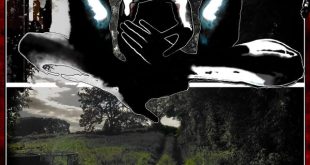
San Francisco-based singer-songwriter Eric Anders has put together a compilation of his best tracks in Big World Abide: The Best of Eric Anders, released in March 2016. The tracks are taken off his previous albums: Not At One (2003), Songs For Wayward Days (2004), More Regrets (2005), Tethered to the Ground (2006), and Remains In Me (2011).
Many of the tracks are built with the same increase in intensity throughout. The alt rock “Tethered To The Ground” starts only with vocals and guitars. At the halfway mark, a keyboard adds a bit of intensity which is further increased at the two-third mark with the gentle swelling of drums and again at the three-quarter mark with female backing vocals. This is a very typical formula often heard in the music world, but Anders makes it work very well. “Remains In Me” is similarly built with the little variation of a country twang to this otherwise alt rock track.
Other such variations include the folk-flavored “Remembering On My Own”, the pop rock ballad “How Long and Why”, the melancholic “These People”, and the very sad, country-inspired “Looking Forward to Your Fall” (which also features strings). Strings also make an attention-grabbing appearance in “Never Enough”.
A keyboard is often used by Anders as a way of bringing in subtle enhancements to the track in question, rather that as a backbone for an entire track. Typically, the keyboard kicks in around the one-third or halfway mark, such as in “Blister In The Sun”, enhancing the slow and mellow mood with delicate keyboard waves. Similarly, in the alt rock ballad “Settlin’ Comes”, the keyboard adds a certain extra coziness already generated by the combination of vocals, percussion, and guitars. Only in the pop rock track “Icarus” does the keyboard come in as a heavier-use instrument.
Interestingly enough, the “normal” vocals are one of the strengths of this album. Anders doesn’t have vocals that are attention grabbing or particularly unique; he has vocals that anyone with some musical training can achieve. But he knows how to carry a tune and how to emote, which makes every track on his album more accessible somewhat to the layman.
Of particular note is the track “Genocide And Justice”. After opening rather ominously, a guitar plucks its way through a light melody further lightened by airy vocals. The heavy theme of the track and the serious lyrics come therefore as a major contrast to the melody and vocals they are set in.
This compilation of “Best Of” tracks from Eric Anders’ various albums comes together as a surprisingly coherent whole. The tracks are all built on a limited variation of formulas that become very familiar only a few numbers into the album, with very few deviations from the norm Anders has set for himself. This works. Anders has successfully created a relaxing auditory environment which will probably appeal the most to adult contemporary fans. More information about Eric Anders is available on his official website and on his Facebook page, and tracks are available for streaming on SoundCloud.
Images provided by: Independent Music Promotions.
 Blogcritics The critical lens on today's culture & entertainment
Blogcritics The critical lens on today's culture & entertainment



